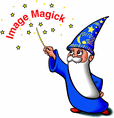

|
conjure - process a Magick Scripting Language (MSL) script
WARNING: Conjure and MSL are in very early development and the
syntax is subject to change!
|
|
conjure [ options ] script.msl
[ [ options ] script.msl ]
|
|
The Magick scripting language (MSL) will primarily
benefit those that want to accomplish custom image processing tasks but
do not wish to program, or those that do not have access to a Perl
interpreter or a compiler. The interpreter is called conjure and here
is an example script:
<?xml version="1.0" encoding="UTF-8"?>
<image size="400x400" >
<read filename="image.gif" />
<get width="base-width" height="base-height" />
<resize geometry="%[dimensions]" />
<get width="width" height="height" />
<print output=
"Image sized from %[base-width]x%[base-height]
to %[width]x%[height].\n" />
<write filename="image.png" />
</image>
invoked with
conjure -dimensions 400x400 incantation.msl
All operations will closely follow the key/value pairs defined in
PerlMagick, unless otherwise noted.
Conjure is in the early stages of development as of
April 2002.
This early announcement is to allow ImageMagick users to contribute ideas
early in the process so when the scripting language is released it will
be useful/stable from the get-go! If you want to contribute suggestions
about the Magick scripting language (MSL), post them to
[email protected].
|
|
Options are processed in command line order. Any option you specify on
the command line remains in effect until it is explicitly changed by specifying
the option again with a different effect, or if it is changed by a statement
in the scripting language.
You can define your own keyword/value pairs on the command line. The script can then use this information when setting values by including %[keyword] in the string. For example, if you included "-dimensions 400x400" on the command line, as illustrated above, then any string containing "%[dimensions]" would have 400x400 substituted. The "%[string]" can be used either an entire string, such as geometry="%[dimensions]" or as a part of a string such as filename="%[basename].png". The keyword can be any string except for the following reserved strings (in any upper, lower, or mixed case variant): debug, help, and verbose, whose usage is described below. The value can be any string. If either the keyword or the value contains white space or any symbols that have special meanings to your shell such as "#", "|", or "%", enclose the string in quotation marks or use "\" to escape the white space and special symbols.
Keywords and values are case dependent. "Key",
"key",
and "KEY" would
be three different keywords.
For a more detailed description of each option, see
ImageMagick(1).
|
The Magick Scripting Language (MSL) presently defines the following
elements and their attributes:
|
|
John Cristy,
[email protected],
ImageMagick Studio LLC, |
|
Copyright (C) 2002 ImageMagick Studio Permission is hereby granted, free of charge, to any person obtaining a copy of this software and associated documentation files ("ImageMagick"), to deal in ImageMagick without restriction, including without limitation the rights to use, copy, modify, merge, publish, distribute, sublicense, and/or sell copies of ImageMagick, and to permit persons to whom the ImageMagick is furnished to do so, subject to the following conditions: The above copyright notice and this permission notice shall be included in all copies or substantial portions of ImageMagick. The software is provided "as is", without warranty of any kind, express or implied, including but not limited to the warranties of merchantability, fitness for a particular purpose and noninfringement.In no event shall ImageMagick Studio be liable for any claim, damages or other liability, whether in an action of contract, tort or otherwise, arising from, out of or in connection with ImageMagick or the use or other dealings in ImageMagick. Except as contained in this notice, the name of the ImageMagick Studio LLC shall not be used in advertising or otherwise to promote the sale, use or other dealings in ImageMagick without prior written authorization from the ImageMagick Studio. |